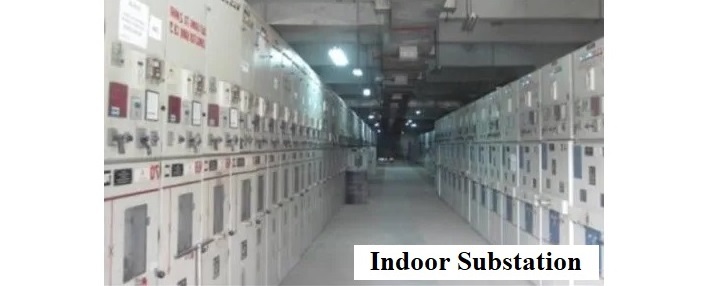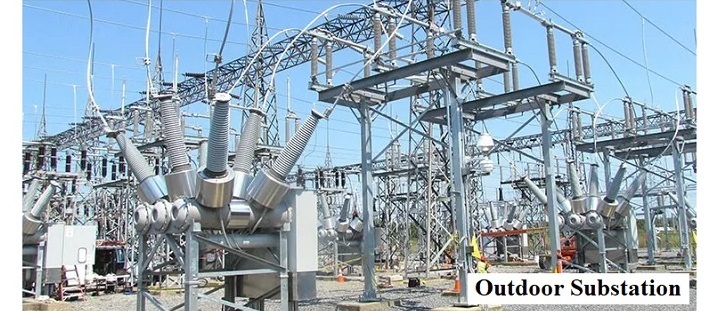
 Data Structure
Data Structure Networking
Networking RDBMS
RDBMS Operating System
Operating System Java
Java MS Excel
MS Excel iOS
iOS HTML
HTML CSS
CSS Android
Android Python
Python C Programming
C Programming C++
C++ C#
C# MongoDB
MongoDB MySQL
MySQL Javascript
Javascript PHP
PHP
- Selected Reading
- UPSC IAS Exams Notes
- Developer's Best Practices
- Questions and Answers
- Effective Resume Writing
- HR Interview Questions
- Computer Glossary
- Who is Who
Difference between Indoor and Outdoor Substations
An indoor substation is one in which the entire substation is built inside a building, whereas an outdoor substation is a substation in which the equipment are installed in an open environment.
Read this article to understand all the important differences between indoor and outdoor substations. Let us start this article with a brief overview on electrical substations, indoor substations, and output substations.
What is a Substation?
A substation or electrical substation is an arrangement of electrical equipment for changing the voltage levels of electric supply for transmission, distribution, and utilization purposes.
Basically, a substation is used for the following four main purposes
- Increasing or decreasing the voltage levels
- Switching of the power supply in the grid
- Controlling the electrical parameters like power factor, frequency, current, etc. of the power system
- Protect the power system against faults and abnormal conditions
Equipment Used in a Substation
A typical substation contains the following electrical equipment -
Power transformer - to change (rise/reduce) the voltage levels of the supply.
Circuit breakers - to turn on or off the power supply in the system.
Isolators - to add extra layer of electrical separation in power lines.
Current transformer - to reduce the high currents to lower values for measurement and protection.
Potential transformer - to reduce the high voltage to lower values for measurement and protection.
Busbars - to connect incoming and outgoing power lines with the substation.
Lightning arrestors - to protect the system from damages due to switching surges or lightening surges.
Insulators - to separate conducting parts from non-conducting parts.
Metering instruments - to monitor and display different readings.
All these are some important equipment used in a substation. However, there are several other equipment also present in an actual substation.
Based on the installation, substations can be classified into the following two types: Indoor Substations and Outdoor Substations.
What is an Indoor Substation?
An electrical substation in which the entire substation arrangement is setup inside a building is referred to as an indoor substation.

Indoor substations are mainly used in areas where the atmospheric surrounding is impure or contaminated.
Indoor substations are generally designed for a voltage level of 11 kV. But in some special case, they can be erected up to 66 kV.
What is an Outdoor Substation?
An electrical substation in which the entire substation arrangement is erected outside in an open-air environment is referred to as an outdoor substation.

It is a very common substation design used in actual practice. These substations can be erected for any voltage levels up to 765 kV.
Difference between Indoor and Outdoor Substation
The following table highlights all the significant differences between indoor and outdoor substations -
| Parameter | Indoor Substation | Outdoor Substation |
|---|---|---|
| Basic | A substation in which all electrical equipment are installed inside a building is called an indoor substation. | A substation in which electrical equipment like transformer, circuit breakers, isolators, etc. are installed outside in an open environment is called an outdoor substation. |
| Design complexity | Indoor substations have compact and complex design. | Indoor substations have an open design which relatively less complicated. |
| Voltage level | Indoor substations are generally erected for voltage levels up to 66 kV. | Outdoor substations can be erected for any voltage levels up to 765 kV. |
| Location of equipment | In indoor substations, the electrical equipment like transformer, circuit breakers, isolators, etc. are located inside a building. | In outdoor substations, the electrical equipment like transformers, circuit breakers, isolators, etc. are located outside the building. |
| Space | Indoor substations consume a smaller space. | Outdoor substations consume a large space. |
| Expansion | Indoor substations are not easy to expand. | Outdoor substations can be easily expanded with the increasing demand of the load. |
| Cost | The overall cost of an indoor substation is less as they are smaller in size. | The cost of outdoor substation is high because they consume a large land area. |
| Equipment visibility | Equipment of an indoor substation are not easily visible because they are installed inside a building. | Equipment of an outdoor substation are clearly visible as they are installed in open space. |
| Handling faults | Indoor substations have a detailed document of the complete setup, hence, their fault handling is easier. | Outdoor substations have an open design and less documentation. Thus, fault handling in outdoor substations is complicated. |
| Maintenance | Indoor substations require high maintenance. | Outdoor substations require less maintenance. |
| Replacement of equipment | In indoor substations, the replacement of equipment is difficult due to fitted system. | In outdoor substations, the replacement of equipment is relatively easier. |
| Safety | Indoor substations are relatively safer. | Outdoor substations have open design, hence, they are not much safer. |
| Clearance | In indoor substations, all the electrical equipment are individually insulated. Thus, a small clearance between them is enough. | In outdoor substations, the overhead lines or busbars are not insulated. Thus, they require more clearance. |
Conclusion
In this article, we explained in detail about electrical substations, indoor substations, outdoor substations, and the key differences between them. By referring the above comparison table of indoor and outdoor substations, we can select a suitable one for our utility application. Both substations have their own advantages and disadvantages.
FAQs Related to Indoor Vs Outdoor Substations
The following section of the article answers all the most commonly asked questions related to difference between indoor and outdoor substations.
1. What are the advantages of an indoor substation over an outdoor substation?
The following are some major advantages of an indoor substation over an outdoor substation -
- Indoor substations have a closed and insulated design inside a building. Hence, they are safer than outdoor substations.
- Indoor substations are free from all kind contaminations like dust, moisture, etc.
- Indoor substations are more reliable than outdoor substations, as they are not directly exposed to the weather conditions.
- Indoor substations are relatively cheaper to maintain.
- Less space is required for installation of the substations.
2. What are the advantages of outdoor substation?
The main advantages of an outdoor substation are listed below -
- Outdoor substations have open design that makes fault detection easier.
- Outdoor substations can be easily expanded any time.
- Time required to erect outdoor substations is relatively lower, as they involve construction and erection work parallelly.
- A smaller building and hence less building construction material is required in outdoor substations.
- Equipment and switchgears used in outdoor substations are relatively less expensive.
3. What is the purpose of an indoor substation?
The main purpose of an indoor substation is to convert the high-voltage electric supply into a low voltage supply which is suitable for utilization by homes, businesses, and other consumers. Indoor substations are installed inside a building for many reasons like protection against extreme weather conditions, unauthorized access, etc.
4. Is an indoor substation more expensive than outdoor substation?
No, indoor substations are usually installed for low or medium voltages and require a very less land area for erection. Thus, they are not expensive than outdoor substations that require a very large land area which is very expensive.
5. What is an example of an indoor substation?
A low voltage substation inside a factory is an example of indoor substation.

